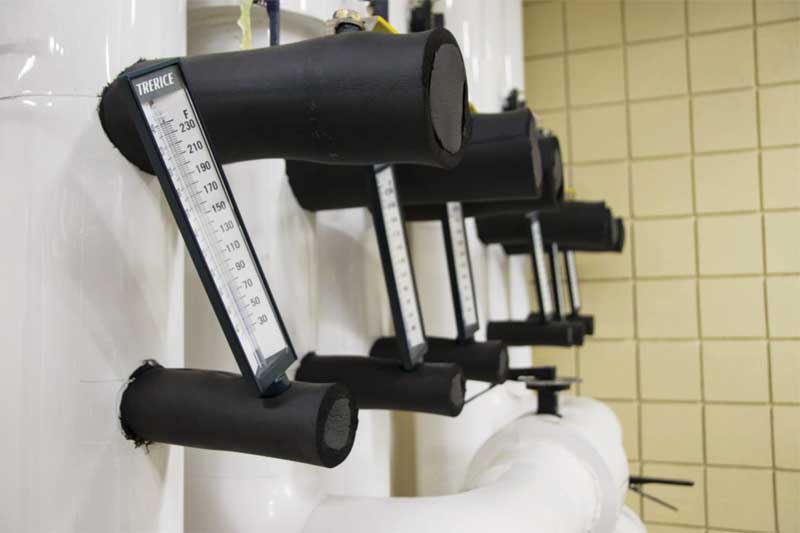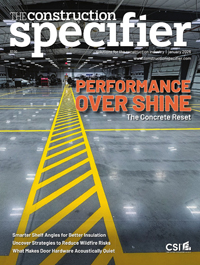Taking HVAC performance beyond the baseline: Combining geothermal, DOAS, and chilled beams

The software also intuitively manages the borefield via the project’s hybrid wet/dry closed circuit cooling tower. The cooling tower can be used to pull heat out during cooler nights, without the expense of running the chiller, so the field can be more efficient the following day.
“The software perpetually runs building load analytics and then reprograms itself every five days for better efficiency in a self-adapting approach,” said Hamstra.
Other alternatives to conventional HVAC systems that are controlled either with the Greensleeves’ software or the BAS are:
- fume hood systems’ air-quality sampling;
- a packaged, factory-assembled energy chassis that includes the chiller, seven variable frequency drive (VFD) pumps ranging from 1.5 to 15-hp, valves, piping, air separators, heat exchanges, and sensors; and
- a seven-zone geothermal variable refrigerant flow (VRF) system used for stairwell and vestibule conditioning.
Economics up-front and over time
Hamstra said he sees chilled beams as continuing to take market share from heat pumps when it comes to geothermal designs.

“However, designers must consider condensation and humidity control along with DOAS. Another important consideration is getting the greatest capacity and efficiency from a geothermal system by using the warmest water temperatures possible for cooling and the coolest for heating,” he explained.
Compared with conventional systems using a chilled water loop, chiller, cooling tower, and VAV boxes with hot water coils, the University of Findlay system is only $1/sf higher in equipment costs, which amounts to approximately $75,000. The additional equipment expense will be paid back immediately if the school receives a proposed energy rebate from local utility AEP Ohio’s energy-efficient product installation program.
The Davis Building is the most efficient of the university’s 232,260 m2 (2.5 million sf) of academic/athletic and residence buildings, explained the school’s physical plant director, Myreon Cobb.
“The building’s performance monitoring is still ongoing, however we’re presently attaining the energy savings that was proposed,” he said.
| CHOOSING DESICCANT WHEEL ENERGY RECOVERY EQUIPMENT: THINK RER, NOT ROI |
| Energy recovery with desiccant wheels should not be specified purely on efficiency ratings and capital cost, without regard to static pressure. This advice comes from the Air-conditioning Heating and Refrigeration Institute (AHRI) Guideline V, Calculating the Efficiency of Energy Recovery Ventilation and its Effect on Efficiency and Sizing of Building. Doing so may in fact defeat a building owner’s attempt to maximize long-term energy savings.
Instead of choosing desiccant wheel equipment for return-on-investment (ROI), a wheel should be reviewed for its recovery efficiency ratio (RER), according to AHRI Guideline V. The RER takes into consideration the efficiency and the static pressure of a desiccant wheel. Not calculating the RER could result in tens of thousands of dollars in lost energy savings over the course of the desiccant wheel’s lifecycle. Intended for service contractors, engineers, and building owners, AHRI Guideline V provides a means for calculating the impact of applied energy recovery equipment on the energy efficiency of the HVAC system at a single selected operating condition. More simply, the calculations comprehensively take a host of factors into consideration, such as geographical climate, fan/motor efficiency, exhaust air transfer ratio (EATR), pressure drop, and energy recovery methodology. Guideline V also allows specifying engineers (manufacturer representatives can also perform the service) to compare energy recovery ventilation (ERV) wheels and arrive at a comprehensive savings for heating and cooling, rather than just a wheel manufacturer’s efficiency rating that doesn’t consider all variables. |
Thomas Rice is director of sales at SEMCO LLC, a Fläkt Woods Company specializing in energy recovery equipment, chilled beams, spiral metal ductwork, and acoustical products. He has 15 years of experience in HVAC/R and has assisted, consulted, and participated in the specification and installation in dozens of high-profile CB and dedicated outdoor air system projects. Rice serves on American Society of Heating, Refrigerating, and Air-conditioning Engineers (ASHRAE) technical committees for room air distribution, air-to-air energy recovery, and desiccant dehumidification components. He can be reached at thomas.rice@flaktwoods.com.






